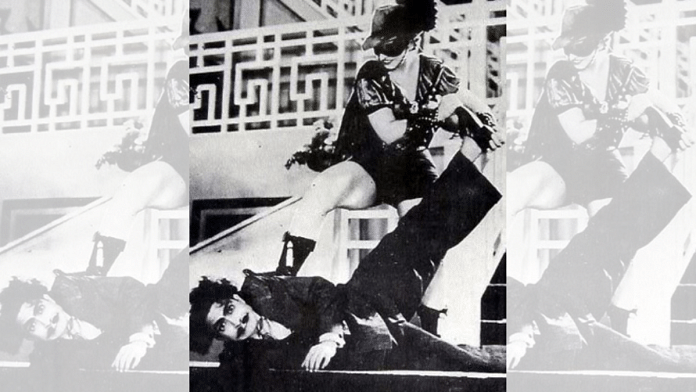Mary Ann Evans, best known as ‘Fearless Nadia’, redefined heroism in Indian cinema and ruled the Hindi marque during the 1930s. Indian cinephiles remember the Hunterwali’ from the 1935 movie with the same name as the ‘masked and cloaked adventurer’.
Born in Perth, Australia, the blue-eyed blonde actress was the first to perform death-defying stunts in Bollywood movies in the years before Independence. Having come to India at the age of five in 1913, Nadia lived through tested times in Indian history — World War I, the growing freedom movement, the Great Depression, and then World War II. On celluloid, Indians saw her become the symbol of fearlessness with her no-body-double stunts. A scene from Jungle Princess (1942) in which she is taming lions inspired her husband and producer, Homi Wadia, to give her the moniker ‘Fearless Nadia’.
Not just a stuntwoman
Nadia left audiences awestruck by delivering some of the best thrilling scenes Indians had ever watched — swinging from chandeliers, jumping off cliffs, climbing roofs, and punching men atop moving trains.
She spoke about her stuntwork in a 1989 interview with the BBC for a documentary focussing on the history of Indian cinema. The swashbuckling movie star is seen saying nonchalantly: “In all our pictures, the stunts were dangerous, but in Jungle Princess (1942), I worked with two lions and two lionesses and the trainer told me not to be afraid. ‘You just look at the lion’s eyes and don’t blink, he will follow you, you keep on looking into his eyes and then you will come to know that he has started listening to you…I listened to him [trainer]… I pulled their [lions’] tail, sat on them, and opened their mouths.”
But Nadia was not just a stuntwoman, she was a feminist icon too who shrugged off the meek, damsel-in-distress trope that was popular in Indian cinema during the ’40s. Her comparison with the American actress Pearl White, who was famous for performing her own stunts, most notably in The Perils of Pauline (1914), throws light on this. In her 2013 book Bombay Before Bollywood, British journalist Rosie Thomas noted that Nadia was a fighter and not just a daredevil stuntwoman.
“Nadia was always the primary agent of the villain’s demise and as likely to rescue her hero as be rescued,” Thomas wrote.
Her films always carried serious messages on women’s rights and empowerment. In Diamond Queen (1940), Nadia performed stunts and played Madhurika, fighting corruption and advocating for women’s education, while encouraging Indian women to rise up against patriarchy. “If the nation is to be freed, the women have to be free first,” she said in the film.
Also read:Before PS:1 and Baahubali, Sohrab Modi gave India one of its first big-budget epics
From Mary Evans to Fearless Nadia
Nadia’s father was a Scots soldier and volunteer in the British Army, while her mother was a Greek belly dancer. Her family moved to Bombay at the start of World War I when her father was posted there, and then her family decided to stay back in India.
After shifting to Peshawar when her father died in 1915, Nadia learnt horse riding. She even went on to try her hand at ‘unladylike passions’ — fishing, hunting, and shooting. And then she kept pursuing what she loved, mastering cartwheeling and splits. Her mother taught her to sing and dance and encouraged her to watch Indian cinema.
Nadia returned to Bombay and took up a regular job — as a salesgirl in the Army & Navy Store. But her passion for films inspired her to take ballet classes under Madam Astrova at whose studio she performed for British soldiers and Indian royalty.
Many accounts say that the actress changed her name when an Armenian soothsayer told her that she would be successful if her name started with an ‘N’. A few years later, she landed a job at Zarco Circus, and from there she started her journey in the movie industry.
Nadia’s entry into the film industry wasn’t smooth. Jamshed Boman Homi Wadia and Homi Wadia, owners of Wadia Movietone — the production house behind Hunterwali — came across Nadia when a local cinema owner spotted her dancing to Bollywood songs.
In Desh Deepak (1935), Nadia played a slave girl and in Noor-e-Yaman (1935), a princess. But it was her role as Hunterwali — a masked vigilante who protected the poor and punished the villains — that catapulted Nadia to stardom and made Homi Wadia fall in love with her.
The ‘Nadia fever’ spanned over two decades. She performed in over 50 Hindi films, including hits like Punjab Mail (1939), Diamond Queen (1940), and Jungle Princess (1936). While she withdrew from the silver screen in the 1950s, Homi Wadia decided to make a James Bond-style movie called Khilari in 1968 in which she played the role of a spy codenamed Living Fireball’. She was 59 at that time.
(Edited by Humra Laeeq)



